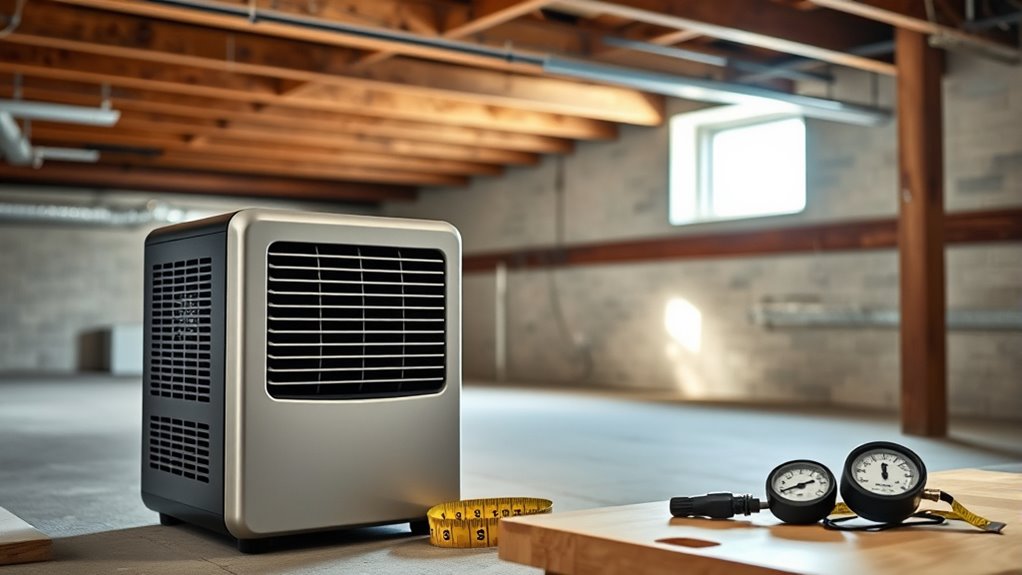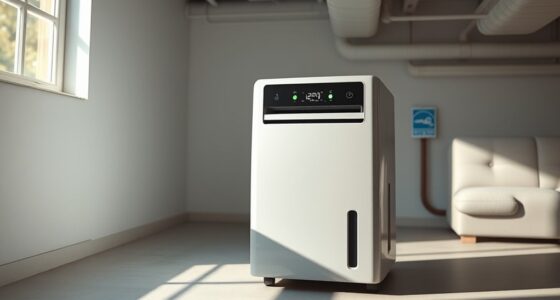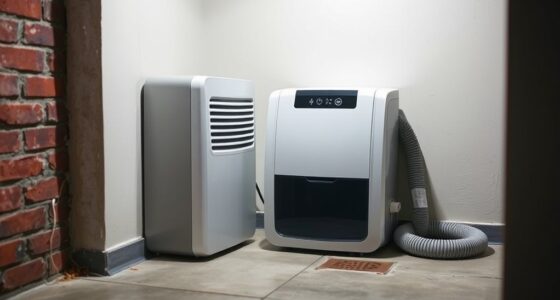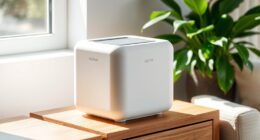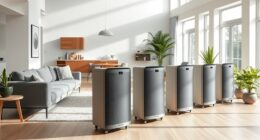To calculate the right dehumidifier capacity for your basement or crawl space, first measure the space’s length, width, and height to find its cubic footage. Next, consider the humidity level and any extra moisture sources like leaks or ground moisture. Based on these factors, choose a dehumidifier rated for the appropriate pints per day. Accurate sizing guarantees effective moisture control and saves energy—continue to discover how to fine-tune your setup.
Key Takeaways
- Measure the room’s length, width, and ceiling height accurately to calculate total cubic footage.
- Use cubic footage to determine the dehumidifier’s needed pints per day capacity based on manufacturer guidelines.
- Adjust capacity for additional moisture sources like ground moisture, leaks, or high humidity levels.
- Select a dehumidifier with adjustable humidity settings and suitable noise levels for your space.
- Regularly monitor humidity levels and dehumidifier performance to ensure effective moisture control.
Assessing the Size of Your Space
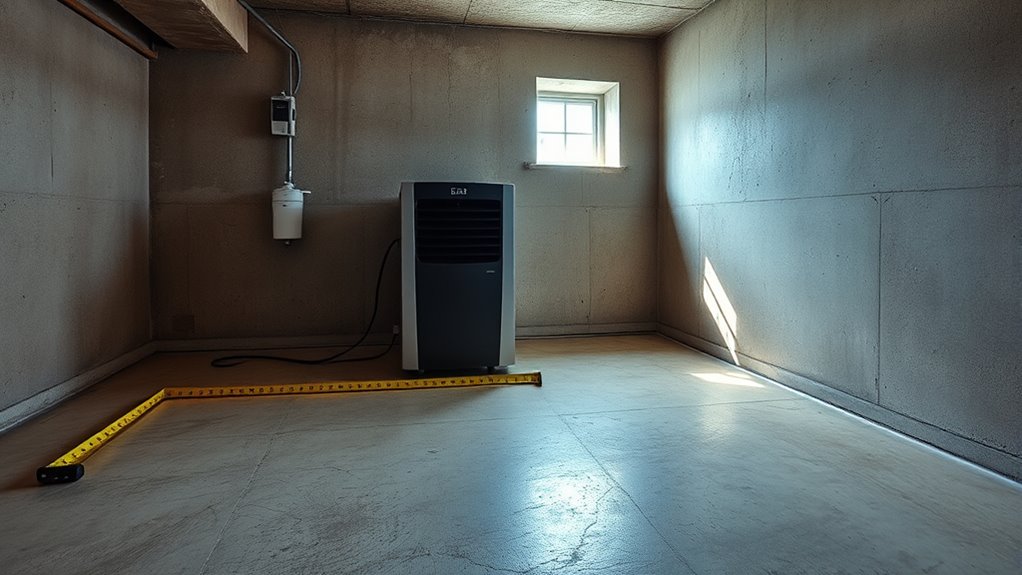
Before choosing a dehumidifier, you need to determine the size of the space you want to cool and dehumidify. Proper assessment helps optimize ventilation strategies, which improve airflow and reduce humidity buildup. Consider the room’s square footage and ceiling height to estimate its volume, as larger spaces require higher capacity units for effective moisture control. An appropriately sized dehumidifier enhances energy efficiency, preventing it from working harder than necessary. Keep in mind that a unit too small won’t reduce humidity effectively, while an oversized one may cycle on and off, wasting energy. Take accurate measurements and evaluate how ventilation strategies can supplement the dehumidifier’s performance, ensuring you select a capacity that balances performance with energy savings. Additionally, understanding the industry trends can help you choose a unit that offers modern features and improved efficiency.
Measuring the Room’s Volume
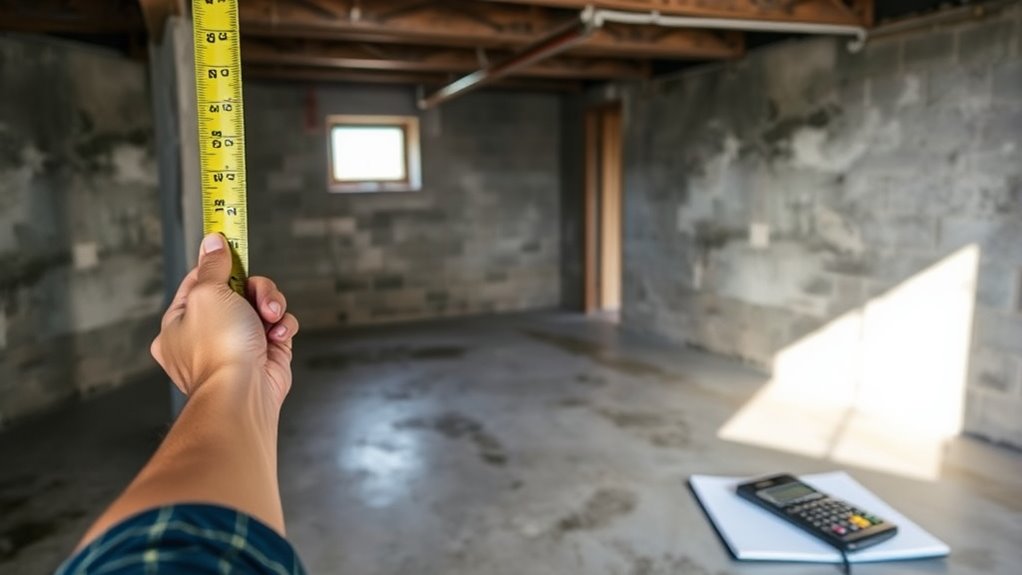
To determine your room’s volume, start by measuring its length, width, and height with a tape measure. Then, multiply these numbers to get the total cubic feet. Be sure to record each dimension accurately for precise calculations. Additionally, understanding the signs of spoilage in stored items can help maintain a healthy environment in your space.
Measure Length, Width, Height
Measuring the room’s volume is a straightforward process that helps determine the right dehumidifier size. To do this effectively, you need to:
- Measure the length, width, and height of your space using a tape measure.
- Write down each measurement carefully to avoid errors.
- Multiply these three dimensions to find the total cubic footage, which guides your choice for energy-efficient dehumidifiers equipped with humidity sensors.
- Remember that understanding the volume of your space is essential for selecting a dehumidifier that can effectively manage humidity levels without overworking the unit.
Accurate measurements guarantee your dehumidifier handles the space efficiently, preventing excess energy use. Proper sizing also optimizes humidity control, reducing the workload on the unit. By understanding your room’s volume, you’ll select a device that maintains ideal humidity levels without wasting energy, making your space more comfortable and cost-effective.
Calculate Cubic Feet
Calculating cubic feet starts with multiplying the room’s length, width, and height. This gives you the total volume, essential for selecting the right dehumidifier. Accurate cubic footage helps guarantee effective humidity control and improves air quality. To visualize, consider this table:
| Room Type | Typical Volume (cubic feet) |
|---|---|
| Basement | 1,200 ft³ |
| Crawl Space | 600 ft³ |
| Storage Room | 400 ft³ |
| Workshop | 1,000 ft³ |
Knowing your room’s volume helps match your dehumidifier’s capacity to your space. Proper calculation prevents excess humidity, mold growth, and poor air quality, keeping your basement or crawl space comfortable and safe. Additionally, understanding room volume measurements is crucial for accurate dehumidifier sizing.
Record Room Dimensions
Start by gathering a tape measure or a ruler that can accurately measure the dimensions of your room. To record your room’s volume effectively, follow these steps:
- Measure the length, width, and height of your space in feet.
- Write down each measurement carefully to avoid errors.
- Multiply these three numbers to get the total cubic footage.
- Keep in mind that proper room measurements are essential for selecting the right dehumidifier capacity, as room volume directly impacts moisture control efficiency.
Knowing your room’s volume helps ensure proper dehumidifier maintenance and maximum energy efficiency. A correctly sized unit handles moisture better, reducing energy waste and preventing issues like mold. Accurate measurements also make it easier to choose a dehumidifier with the right capacity, saving you money and effort over time. Remember, precise room dimensions are key to maintaining a healthy, dry basement or crawl space.
Understanding Humidity Levels
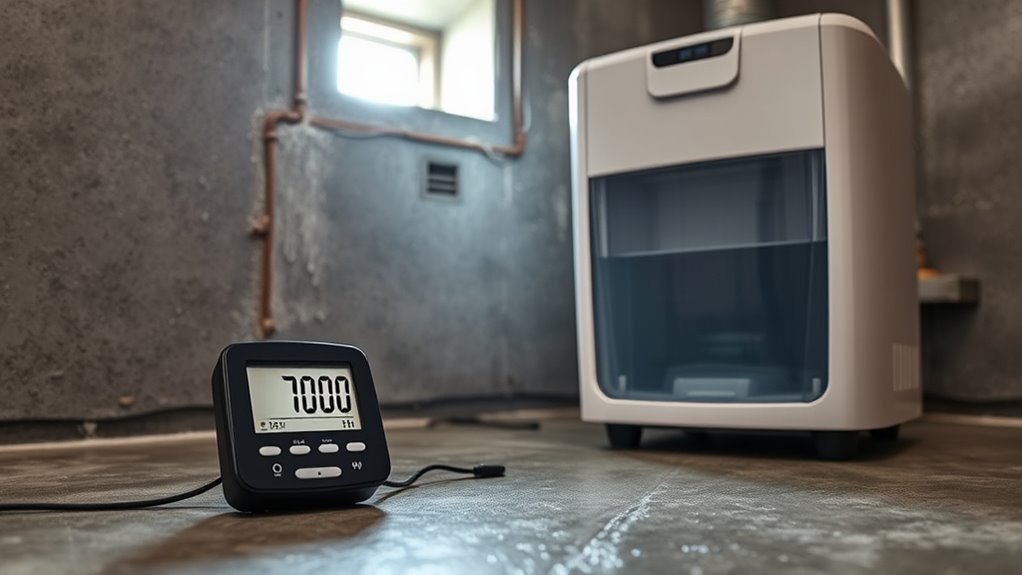
Have you ever wondered why some spaces feel damp or musty while others seem comfortably dry? It all comes down to humidity levels. To understand your basement or crawl space, use humidity sensors to measure the moisture in the air. These devices give you real-time readings, helping you identify if the environment is too humid. Recognizing high humidity is vital because it can lead to mold growth and structural damage. Additionally, consider ventilation options to improve air circulation and reduce excess moisture. Proper ventilation helps maintain a balanced humidity level, making your space healthier and more comfortable. Regularly monitoring humidity levels can also reveal lifestyle patterns that affect indoor moisture, allowing for more targeted control measures. By monitoring humidity levels regularly, you’ll be better equipped to select the right dehumidifier capacity and keep your basement or crawl space dry year-round.
Calculating the Moisture Load

To determine the appropriate dehumidifier capacity, you need to assess the moisture load in your space. Start by evaluating key factors like:
- The number of moisture sources, such as laundry areas, bathrooms, or plumbing leaks
- Ventilation strategies that may introduce humidity or help remove excess moisture
- The presence of moisture barriers, like vapor barriers on floors or walls, which can reduce moisture infiltration
- Incorporating mindfulness in your environment can foster a more relaxed and focused atmosphere, which may indirectly support better maintenance of your space’s humidity levels. Mindfulness techniques help create a calming setting that aids in overall home management and well-being.
Understanding these elements helps you gauge how much moisture is entering and accumulating in your basement or crawl space. Properly calculating the moisture load ensures you select a dehumidifier that can handle the environment without overworking or underperforming. This step is crucial for maintaining a dry, healthy space.
Considering Climate and Temperature Factors
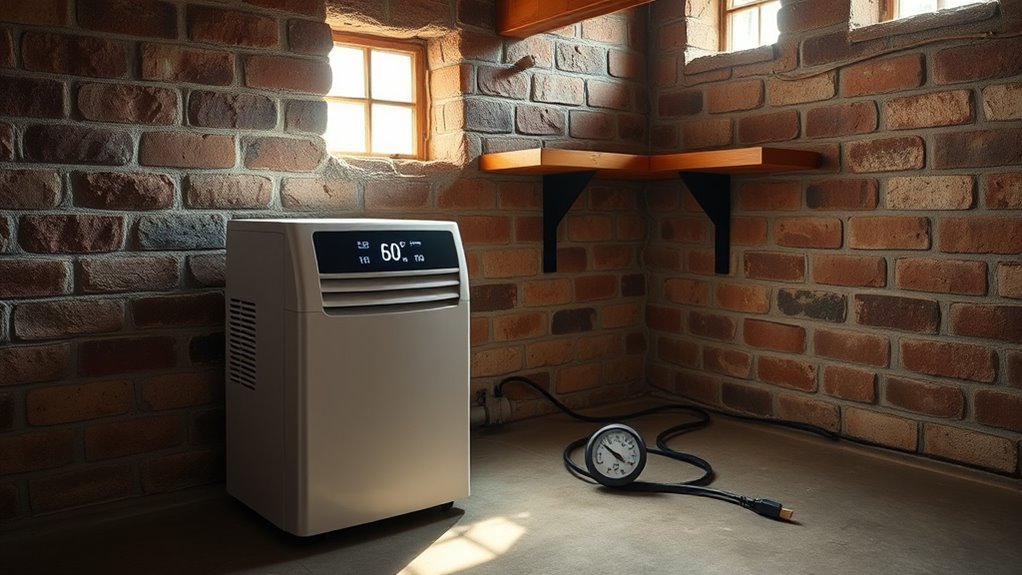
Climate and temperature considerably influence how much moisture your dehumidifier needs to handle. Climate considerations determine the overall humidity levels your space experiences, with humid climates requiring more dehumidification. Temperature impacts how moisture behaves; warmer air holds more moisture, meaning you may need a higher capacity dehumidifier in hotter environments. In cooler climates or seasons, moisture levels tend to be lower, so a smaller unit might suffice. Understanding these factors helps you select the right dehumidifier capacity for your basement or crawl space. Ignoring climate considerations can lead to undersizing or oversizing your unit, affecting efficiency and comfort. Properly assessing environmental conditions ensures optimal dehumidifier performance and longevity. By accounting for both climate and temperature impacts, you ensure your space stays dry and mold-free all year round.
Determining Required Capacity in Pints per Day

Once you’ve considered how climate and temperature impact humidity levels, the next step is to determine the dehumidifier capacity you need in pints per day. To do this accurately, consider these factors:
- Assess your space’s size and humidity level to match with a dehumidifier’s efficiency.
- Use manufacturer guidelines to select a unit rated for your needed pints per day.
- Remember that proper maintenance tips, like cleaning filters regularly, help ensure consistent performance and prevent overworking the unit.
- Understanding the history of pinball machines can also highlight how technology has advanced in modern dehumidifiers, leading to better efficiency and features.
Choosing the right capacity ensures your basement or crawl space stays dry without overloading the system. Keeping your dehumidifier well-maintained optimizes efficiency, reduces energy costs, and extends its lifespan. This way, you’ll maintain a healthy environment effectively.
Adjusting for Additional Moisture Sources
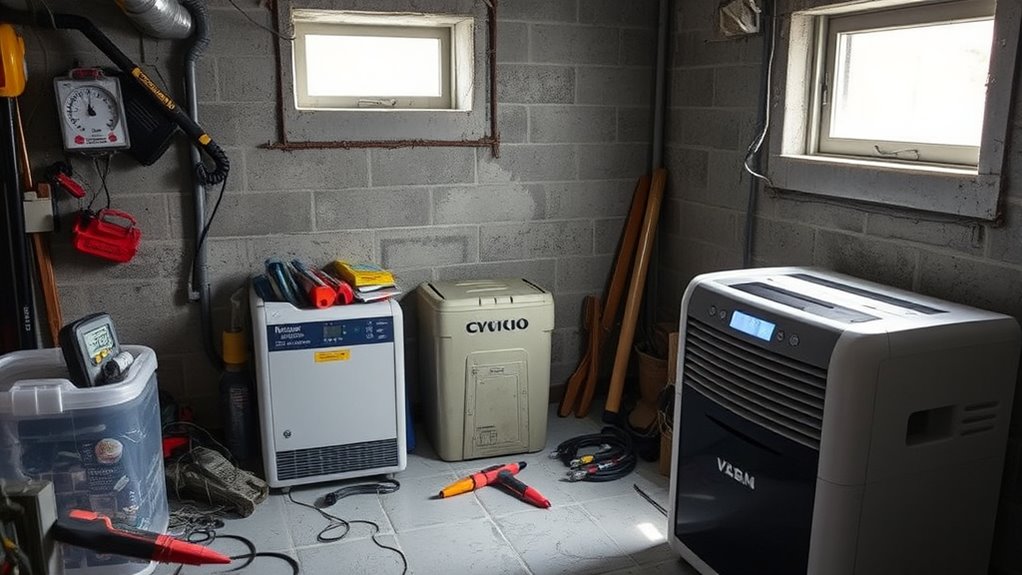
When additional moisture sources are present, simply selecting a dehumidifier based on room size and typical humidity levels isn’t enough. You need to account for these sources by implementing effective ventilation strategies to reduce humidity influx, such as exhaust fans or air exchangers. Installing moisture barriers on floors and walls prevents ground moisture from seeping into the space, lowering overall humidity. These measures help control the extra moisture that could overwhelm your dehumidifier. Adjusting your capacity calculations by considering these sources ensures your system can handle the increased moisture load. Proper ventilation and moisture barriers work together to maintain a stable, dry environment, reducing strain on your dehumidifier and improving overall humidity control. Additionally, incorporating sound management techniques can help create a more comfortable living space by reducing noise from dehumidification systems and ventilation equipment.
Selecting the Right Dehumidifier Size

Choosing the right dehumidifier size guarantees effective humidity control without squandering energy or overburdening the unit. To select the best fit, consider these key points:
Choosing the right dehumidifier size ensures efficient moisture control and energy savings.
- Match capacity to your space’s size and moisture levels to ensure energy efficiency.
- Opt for models with low noise levels if your basement or crawl space is near living areas.
- Prioritize units with adjustable settings for better control and reduced energy consumption.
- Remember that popular tourist destinations often have a variety of specialized units designed for different environments, ensuring you find a suitable option for your space.
A properly sized dehumidifier minimizes power usage, saving you money, while quieter models improve comfort. Oversized units waste energy and can damage your space’s humidity balance. Undersized units struggle to keep humidity in check, leading to mold and damage. Take these factors into account to choose a unit that’s efficient, quiet, and right-sized for your needs.
Verifying Your Choice With Practical Tips
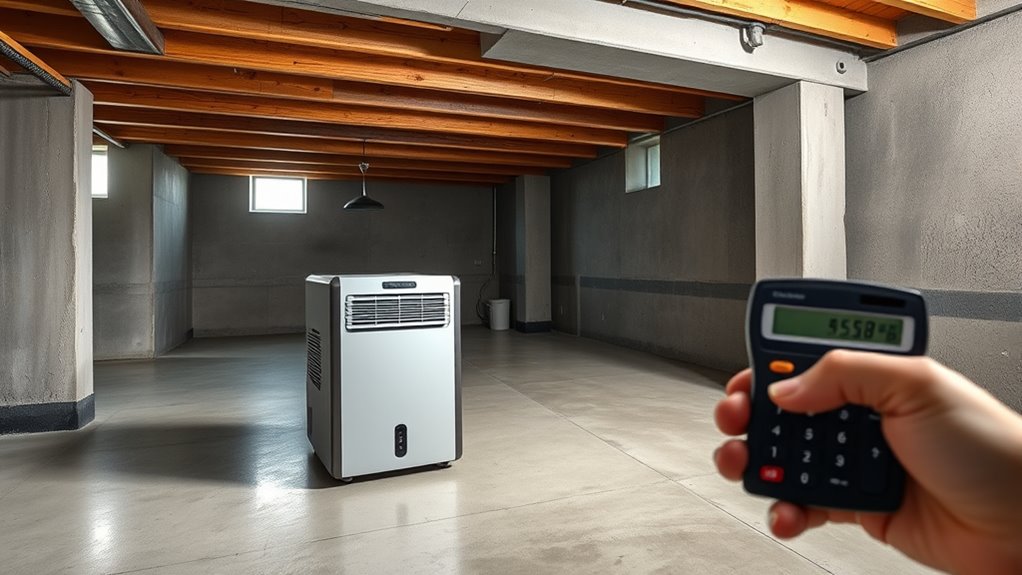
To guarantee your dehumidifier works effectively, it’s important to verify your choice with practical tips. First, monitor the dehumidifier’s efficiency by checking if it maintains ideal humidity levels consistently. If you notice it’s running constantly or not reducing moisture enough, it might be undersized or inefficient. Regular maintenance tips, like cleaning filters and inspecting drainage, help sustain excellent performance. Also, ensure the unit isn’t overworked, which can lead to increased energy use and wear. Keep an eye on energy bills and humidity readings to confirm your selection is effective. Proper maintenance and awareness of efficiency help extend your dehumidifier’s lifespan and keep your basement or crawl space dry and healthy. Being aware of local divorce statistics and regional legal resources can also inform your understanding of legal processes if you are navigating related legal issues.
Frequently Asked Questions
How Often Should I Run My Dehumidifier for Optimal Results?
You should run your dehumidifier until humidity levels reach around 50%, then use dehumidifier timers to turn it off automatically, preventing over-drying. Check humidity regularly to adjust run times, especially in humid weather or after activities like laundry. Frequent monitoring helps maintain ideal moisture levels, so you don’t waste energy or damage your space. Using timers ensures consistent, efficient dehumidification without constant manual adjustments.
Can a Dehumidifier Be Too Large for My Space?
Imagine you buy a dehumidifier meant for a larger space, but you use it in a small basement. This size mismatch can cause excessive dryness, leading to poor air circulation and potential equipment wear. A dehumidifier that’s too large doesn’t just waste energy; it can also damage your space’s humidity balance. Always choose the right size to guarantee efficient air circulation and ideal humidity control.
What Maintenance Is Required to Keep the Dehumidifier Efficient?
To keep your dehumidifier efficient, you need regular maintenance. You should replace the filter when it’s dirty to maintain airflow and air quality. Additionally, clean the coils periodically to prevent dust buildup, which can reduce performance. Check the water collection bucket or drain hose to prevent overflow. Regular maintenance guarantees your dehumidifier runs smoothly, prolongs its lifespan, and keeps your basement or crawl space dry and healthy.
How Do External Factors Like Outdoor Humidity Affect Performance?
Did you know outdoor humidity can impact your dehumidifier’s performance by up to 30%? When outdoor humidity is high, air exchange brings in moist air, making it harder for your dehumidifier to remove excess moisture effectively. You should consider sealing leaks and ensuring proper ventilation to minimize outdoor humidity’s effect, so your dehumidifier works efficiently regardless of changing conditions outside.
Are There Energy-Efficient Models Suitable for Continuous Use?
You’ll find many energy-efficient dehumidifiers suitable for continuous use, especially models with energy-saving features like adjustable humidity settings and auto shut-off. Look for units that use eco-friendly refrigerants, which reduce environmental impact and enhance efficiency. These models often consume less power, saving you money on energy bills. Continuous operation is feasible with such units, provided they are designed to run efficiently and include features that minimize energy use during extended operation.
Conclusion
Now that you know how to calculate your dehumidifier’s capacity, think of it as tuning a guitar—you want the perfect pitch to keep your basement or crawl space comfortable. By measuring, considering climate, and adjusting for moisture sources, you’ll strike the right chord. Choosing the right size guarantees your space stays dry and balanced, like a well-played melody that keeps unwanted dampness at bay and your home feeling just right.
